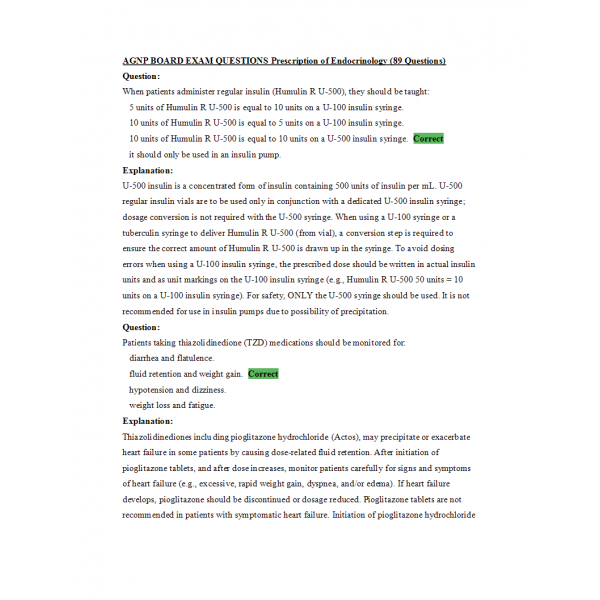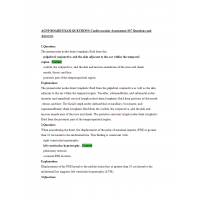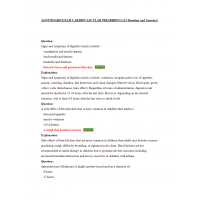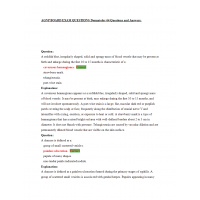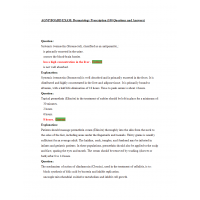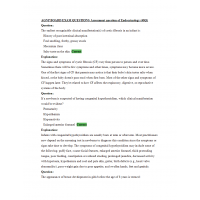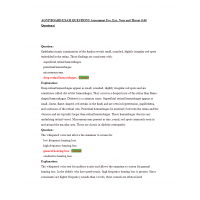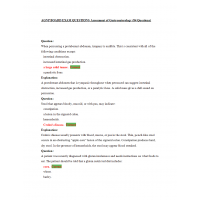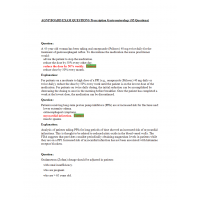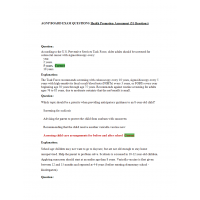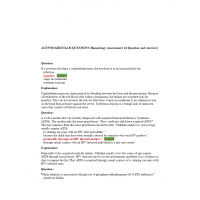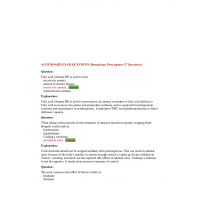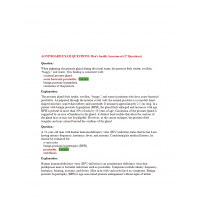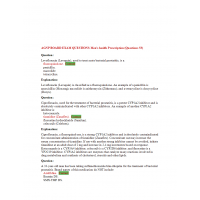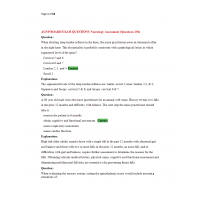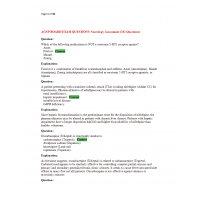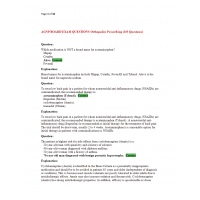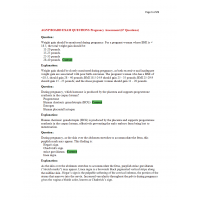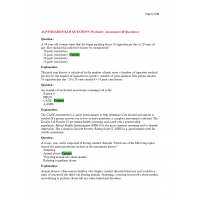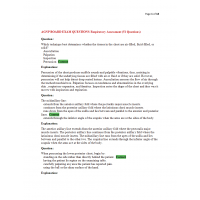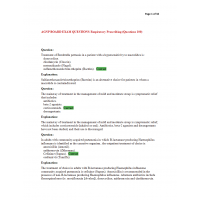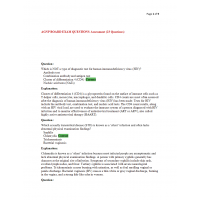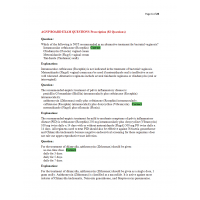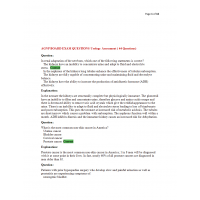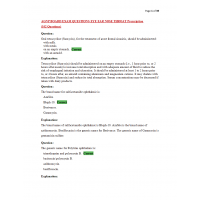AGNP BOARD EXAM QUESTIONS Prescription of Endocrinology (89 Questions)
1. When patients administer regular insulin (Humulin R U-500), they should be taught:
2. Patients taking thiazolidinedione (TZD) medications should be monitored for:
3. A patient diagnosed with Type 2 diabetes mellitus has an initial hemoglobin A1C of 7.2%. Assuming no contraindications, the American Diabetes Association's (ADA) initial recommendation for this patient includes:
4. Gynecomastia is NOT likely to be caused by:
5. Which of the following medications may cause gynecomastia?
6. Sodium-glucose co-transporter 2 (SGLT2) inhibitors reduce blood glucose by:
7. A patient who is started on a glucagon-like peptide (GLP-1), such as Victoza, should be informed that this class of medications may:
8. The most frequent side effect of metformin (Glucophage) is:
9. Patients taking dipeptidyl-peptidase-4 (DDP-IV) inhibitors for the treatment of Type 2 diabetes do NOT routinely need to be monitored for:
10. A patient who has Addison's disease has received a prescription for fludrocortisone. Fludrocortisone acts by:
11. A 63-year-old woman with Type 2 diabetes mellitus has been treated with metformin (Glucophage) for the past 3 months. Baseline estimated glomerular filtration rate was 63. Renal function on this patient should be checked:
12. Because of the mechanism of action, patients should be instructed to administer exenatide (Byetta):
13. A patient has type 2 diabetes and takes NPH insulin. If his blood glucose values are elevated before the evening meal, when should additional NPH insulin be given?
14. Which of the following is a rapid-acting insulin?
15. Pioglitazone hydrochloride (Actos) is contraindicated in patients with:
16. A patient who has Type 2 diabetes has a history of heart failure. He takes aspart (NovoLog) daily. Which drug class, in combination with Novolog, will significantly increase his risk of heart failure?
17. A 48-year-old patient is started on metformin (Glucophage) for Type 2 diabetes (T2DM). The maximum expected hemoglobin A1C reduction after initiation of this medication is:
18. Signs and symptoms of hypoglycemia may be blunted by:
19. Patients receiving atenolol (Tenormin) for symptomatic management of hyperthyroidism should be advised that:
20. A patient is receiving a fast-acting insulin to decrease post-prandial blood sugars. If the bedtime blood sugar is elevated, the patient should be advised to increase the fast-acting insulin dose at:
21. Prior to the administration of methimazole (Tapazole), the nurse practitioner should obtain a baseline:
22. Sulfonylureas such as glyburide (Micronase) are extensively metabolized:
23. Which of the following medication classes should be avoided in patients with Type 2 diabetes mellitus and a comorbidity of moderate to severe heart failure?
24. Insulin detemir (Levemir):
25. Patients receiving insulin detemir (Levemir) are at higher risk for developing:
26. The medication that provides the greatest potential reduction in hemoglobin A1C levels is:
27. Synthroid is a thyroid medication used to treat hypothyroidism. It contains a synthetic form of:
28. Alpha-glucosidase inhibitors such as acarbose (Precose) are contraindicated in patients with:
29. Patients who use insulin glargine (Lantus) should be advised:
30. A patient who has Type 2 diabetes has consistently elevated blood sugars before lunch. When should a fast-acting insulin be added to this patient's regimen?
31. Insulins recommended for use in insulin pump delivery systems include:
32. Radioactive iodine treatment for the permanent treatment of hyperthyroidism is usually administered:
33. In addition to hemoglobin A1C, patients receiving metformin (Glucophage) should be monitored for:
34. Which of the following patients would be at risk for lactic acidosis secondary to metformin (Glucophage) use?
35. Which of the following side effects may be caused by methimazole (Tapazole)?
36. Thiazolidinedione (TZD) medications:
37. Patients who are receiving radioiodine therapy for hyperthyroidism should be advised to:
38. A patient is started on a sulfonylurea (i.e., glyburide). The nurse practitioner informs the patient that sulfonylureas are likely to:
39. Radioiodine therapy is safe to administer to:
40. Undertreatment of hypothyroidism in pediatric patients may lead to:
41. Methimazole for the treatment of Graves' disease is contraindicated in patients:
42. The onset of action of short-acting insulins is:
43. A 35-year-old woman with Type 2 diabetes mellitus has taken 1000 mg metformin twice daily for the past 3 months. Today's hemoglobin A1C has decreased to 7.8%. An appropriate action today is to:
44. A patient with Graves' hyperthyroidism is started on thionamide therapy (methimazole [Tapazole]). The goal is to achieve a euthyroid state within:
45. Alpha-glucosidase inhibitors help to lower serum glucose by:
46. An example of a medication that contains a combination of a sulfonylurea and biguanide is:
47. The expected hemoglobin A1C reduction for patients who are started on a dipeptidyl peptidase-4 (DPP-4) inhibitor such as sitagliptin (Januvia) is:
48. Metformin (Glucophage) is a:
49. Which of the following medications is NOT a potential cause of gynecomastia?
50. The generic name for Victoza is:
51. DPP IV inhibitors such as alogliptin (Nesina):
52. The mechanism of action of methimazole (Tapazole) is to:
53. Victoza (liraglutide), a glucagon-like peptide-1 for the treatment of Type 2 diabetes, may potentially decrease the effectiveness of:
54. Which of the following is an intermediate-acting insulin?
55. A 55-year-old obese woman with Type 2 diabetes mellitus has been receiving metformin and glimepiride daily at highest tolerated doses. Her most recent hemoglobin A1C is 9.0%. How should this be managed?
56. Joe is a 50-year-old diabetic. He took Humulin R-100 6 hours ago, prior to lunch. He is now going to work out. With regard to hypoglycemia during exercise, Joe should:
57. Aspart (NovoLog) should be administered:
58. Levothyroxine use in the first trimester of pregnancy:
59. A 32-year-old woman is diagnosed with hyperthyroidism. The nurse practitioner knows that initiating a beta-blocker:
60. Trulicity (dulaglutide) a glucagon-like peptide-1, would be indicated for use in which of the following patients?
61. Sulfonylureas such as glyburide (Diabeta) are expected to reduce the hemoglobin A1C in patients with Type 2 diabetes mellitus by:
62. Maximum plasma concentrations of glucagon, after intramuscular injection, are observed in approximately:
63. In addition to hypoglycemia, rapid-acting insulins may cause:
64. The most common serious side effect associated with glimepiride (Amaryl) is:
65. A patient is started on exenatide (Byetta) for Type 2 diabetes. Byetta should be discontinued if the patient exhibits:
66. Glyburide (Diabeta) is a:
67. Many medications can enhance the hypoglycemic effect of sulfonylureas. Which medication class does NOT enhance the hypoglycemic effect of sulfonylureas?
68. The mechanism of action by which metformin (Glucophage) improves glucose tolerance is:
69. Thiazolidinediones (TZDs) such as pioglitazone (Actos) reduce A1C by levels by:
70. Levothyroxine (Synthroid) is indicated in the treatment of:
71. Lantus is:
72. Sulfonylurea agents such as glimepiride (Amaryl):
73. Insulin glargine (Lantus) is NOT indicated in the treatment of:
74. What are the benefits of initiating an alpha-glucosidase inhibitors such as acarbose (Precose) for a patient with Type 2 diabetes?
75. Exenatide (Byetta) is classified as:
76. Question:
77. Sodium-glucose co-transporter 2 (SGLT2) inhibitors are oral antidiabetic agents and are known to cause:
anemia.
78. The mechanism of action for glucagon-like peptide-1 (GLP-1) medications like Byetta, Victoza, Trulicity and others is:
79. Glucagon should be administered to the patient who has severe hypoglycemia secondary to:
80. The combination of metformin (Glucophage) and glyburide (Diabeta) for the treatment of Type 2 diabetes is:
81. Which of the following is a short-acting insulin?
82. Which statement about metformin (Glucophage) is correct?
83. Levothyroxine (Synthroid) is best administered:
84. Patients should be advised to take glimepiride (Amaryl):
85. Due to the mechanism of action of meglitinides used in the treatment of Type 2 diabetes, they should be administered:
86. Levothyroxine (Synthroid) would NOT be indicated for the treatment of:
87. The most commonly reported side effect of the GLP-1 medication class is:
88. Insulin promotes the absorption of glucose from the blood in many tissues/organs of the body. In which tissue/organ does this NOT occur?
89. Regular insulin (Novolin R) should be administered:
| Institution & Term/Date | |
| Term/Date | AGNP Exam |
AGNP Board Exam Question and Answers - Endocrinology Prescription
- Product Code: 2020
- Availability: In Stock
-
$40.00

